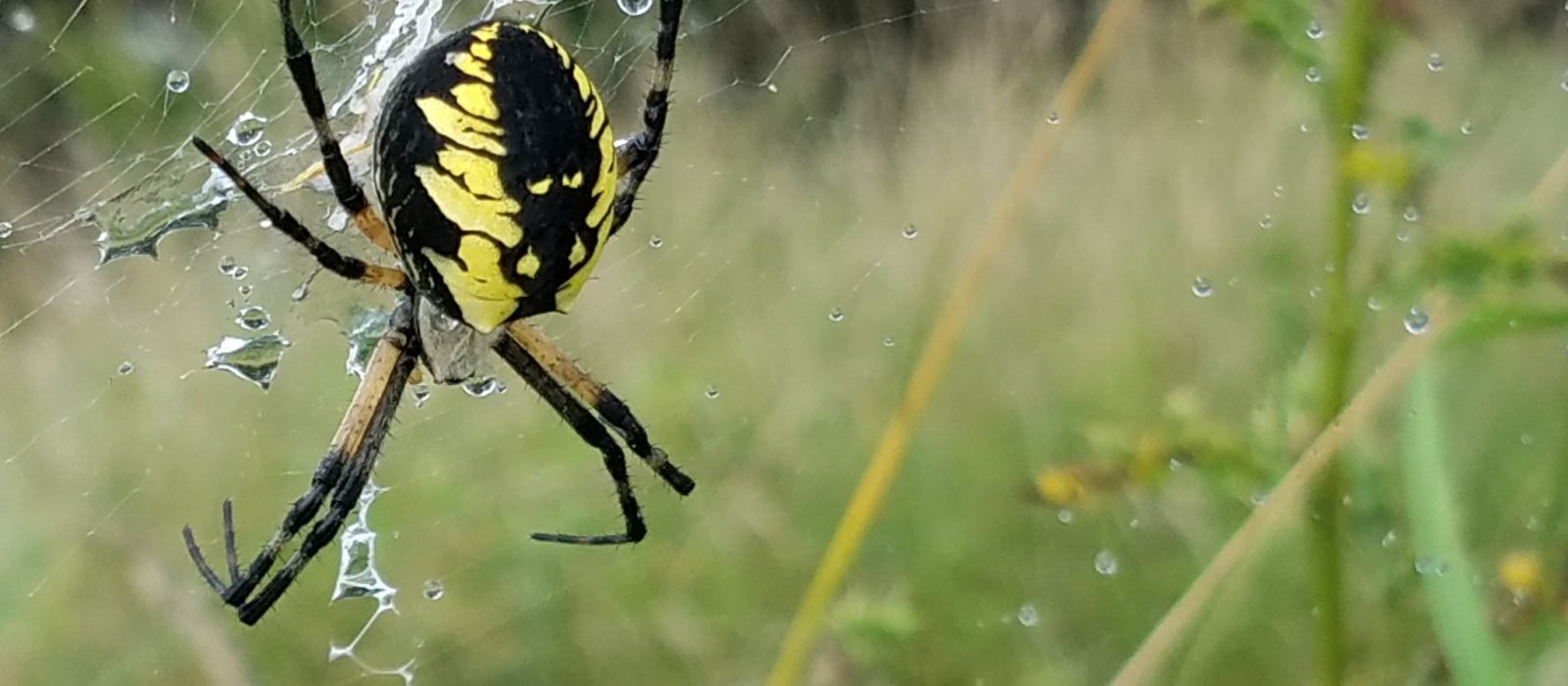subPhylum Chelicerata – Spiders and allies
This group of animals is an ancient one, and representatives have been present at least since the middle Paleozoic era about 425 million years ago. There are three taxomomic classes, of which we have representatives of two on the island: Merostomata includes the horseshoe crab, commonly found on our beaches, and Arachnida (Spiders and related groups) is defined as animals with external skeletons, four pairs of legs and no antennae. World-wide, this class has about 60,000 species out a total of about 75,000 for the phylum. In addition to the spiders, this class includes scorpions, ticks, mites, daddy-longlegs (harvestmen), whip-scorpions, and a few other primitive types.
All spiders belong to the order Araneae, of which there are thought to be at least 4,000 species in mainland United States and Canada. There are thought to be more than 7,000 species on the mainland Eastern Hemisphere, and at least 3,500 of those species are known in the western part of that area known commonly as the Palearctic region (northern “Old World”). More than 215 species are common between the Nearctic and Palearctic regions, the result of an interchange between the two areas thought to have gone on for at least 400 million years (Gertsch, 1979).
Spiders are resourceful and adaptable and have found several ways to get around by themselves. In addition, several species have been transported between Europe and the Western Hemisphere, for example, as undeclared passengers on ships, planes, etc., often in plants being carried from one place to another. Many species also travel by “ballooning,” a process of spinning threads of web and floating on the wind. Although the distances traveled are often not far and seldom over 500 feet above ground, some tiny spiders have been recorded 200 miles from the nearest land and at altitudes of 10,000 feet. This mobility guarantees that new additions to the island’s spider fauna are virtually certain in the future.
About 650 species of spiders are known from New England (Gertsch 1979). Of these, 526 species have been found in the Falmouth area of Cape Cod, just a few miles across Vineyard Sound (R. Edwards, pers. comm.). Indeed, 127 species have been found in roadside mailboxes alone in that area (E. Edwards, pers. comm.). In fact, it appears that there are nearly as many species of spiders on Cape Cod as there are in tropical Costa Rican habitats of the same size (R. Edwards, pers. comm.). The reason for this high species density on the Cape is not known. At least 170 species are known on Nantucket (Emerton, 1930).
By comparison, the Chelicerate fauna of Martha’s Vineyard has been little studied. The original, print version of Island Life listed 82 species have been recorded for our island. Since then, the advent of the community science platform iNaturalist has vastly increased the possibilities for studying Chelicerates, as well as many other types of arthropods. We have added 37 species to this checklist from “Research Grade” iNaturalist records, along with two genus-level additions for which we felt sufficiently strong evidence existed. For many spiders, of course, identification to species level from photographs is simply not possible given the present state of knowledge, and platforms like iNaturalist will never entirely suffice for the study of difficult taxa. But many spiders are visually distinctive (more in some families than in others). And iNaturalist excels at making photographic evidence available for scrutiny by experts. So while we welcome and indeed expect adjustments to this augmented checklist, we feel confident that this list is generally reliable. Additions from iNaturalist to the checklist are indicated in the “Notes” column.
We also expect that, even with the addition of records from iNaturalist, this checklist remains woefully incomplete; it seems certain that the number of spiders actually occurring on the Vineyard exceeds 250. The types of Vineyard spider habitats about which we know the least are salt marshes, beaches and forest trees, all habitats we have in abundance. So a great deal more work remains to be done in order to fully assess this interesting fauna.
An excellent general reference for North American spiders is Gertsch (1979), and Kaston (1972) is a useful general identification key. An excellent recent field guide which also provides much ecological information is Howell and Jenkins (2004). The works of Dondale and Redner (1978, 1982, 1990) and of Dondale et al. (2003) provide distributional and some ecological information. The best regional work for an area close to the island is Kaston’s (1981) detailed study of the spiders of Connecticut.
Ticks and mites number about 30,000 species worldwide. The original Island Life checklist included only two common ones here thought to be vectors of serious diseases such as Lyme, babesiosis, and ehrlichiosis carried by deer; see Wilson and Childs (1997) for a detailed discussion of this topic. Since the appearance of the original print publication, the Lone Star Tick, Amblyomma americanum, has become widely established on Martha’s Vineyard. And iNaturalist also furnishes a single record, its identity reported confirmed by molecular analysis, for the Groundhog Tick, Ixodes cookei.
Allan R. Keith; edited by Matt Pelikan, October 26, 2022
References
Emerton, J. H. 1930. Spiders of Nantucket. The Nantucket Maria Mitchell Association. Vol. III, No. 2, pp. 161-174.
Gertsch, W. J. 1979. American Spiders. Van Nostrand Reinhold Company, New York. Second edition. 274 pp.
Howell, W. M. and R. L. Jenkins. 2004. Spiders of the eastern United States- a photographic guide. Pearson Education, Inc., Boston, MA. 363 pp.
Kaston, B. J. 1978. How to know the spiders. The pictured key Nature Series, Wm. C. Brown Company Publishers, Dubuque, Iowa. Third edition. 272 pp.
————— 1981. Spiders of Connecticut. Bulletin 70 (revised edition), State Geological and Natural History Survey of Connecticut, Department of Environmental Protection. Hartford, CT. 1020 pp.
